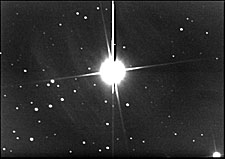
(Here's a photo of the Pleiades taken in the 1950's from Ryerson through a Schmidt camera. Merope is at the top).
While at Lick Observatory, E.E. Barnard noticed a small bright nebula right next to the very bright star Merope in the Pleiades. The existence of the faint bluish nebula surrounding Merope had been discovered by Wilhelm Tempel in 1859, although argued about until photography proved its existence. Barnard though found a bright, tiny nebula extremely close to Merope on the evening of November 14th, 1890. He writes in Astronomische Nachrichten, volume 126, p.293:
On Nov. 14 while examing the cluster, I discovered a new and comparatively bright round cometary nebula close south and following Merope, every precaution was taken to prove that it was not a ghost of Merope by examing the other stars of the group under the same conditions. I have since seen it several times and on Dec. 8th I could see it with some difficulty in the 12 inch by occulting Merope with a wire in the eyepiece. With the great telescope the nebula can be seen fairly well with Merope in the field and is conspicuous when the star is placed just outside the north edge of the field. It is about 30" in diameter, of the 13m , gradually brighter in the middle and very cometary in appearance. It was examined with powers of 300, 520 and 1500 with all of which it was comparatively easy.
In later papers like Astronomische Nachrichten, volume 127, p.135 he reports it seems significantly different from the wispy reflection nebulae that surround Merope and the other Pleiades and that it hadn't been photographed before merely because it was so close to the blindingly bright Merope.

I caught some of the wispy Merope Nebula with a non-blue sensitive CCD camera from Chicago a while ago.
Since reflection nebulas are made of small dust particles, smaller than a wavelength of light, they scatter smaller wavelength light much more effectively than longer wavelengths and turn quite blue (like tobacco smoke seen from the side). When you see blue smoke coming from car's exhaust (and that oil is burning in the engine), you can make a smart guess that the particulates are under 700nm in size. If they were any bigger, they would look white.
Some confusion has occurred in discussing this nebula. The small bright nebula is "Barnard's Merope Nebula" or IC 349. The diffuse nebula surrounding Merope is called "Merope Nebula" which is NGC 1435.
Johannes Schedler's Merope close-up is a fantastic capture of both the nebula, bright Merope, and the faint wispy Pleiades nebula.
Roland Christen's close-up
Herbig later describes the nebula is great detail: Herbig: IC 349: Barnard's Merope Nebula and details how it's not the same dust that makes up the wispy Pleiades nebula, but something different, something with a separate velocity through space.
Later, he has Hubble look at it: http://imgsrc.hubblesite.org/hu/db/2000/36/images/a/formats/web_print.jpg
Barentine and Esquerdo also talk about it here: http://www.journals.uchicago.edu/AJ/journal/issues/v117n3/980312/980312.html (may require subscription).
No comments:
Post a Comment